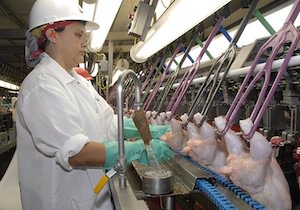Bird Is Not the Word in New USDA Rules
The Obama administration is set to dramatically reduce the USDA's oversight of the nation's poultry slaughterhouses while allowing companies to speed up their kill lines.
The Obama administration is set to dramatically reduce the USDA’s oversight of the nation’s poultry slaughterhouses while allowing companies to speed up their kill lines.
The new rules would reduce the four USDA inspectors currently overseeing kill lines operating at 140 birds per minute to one inspector overseeing 175 birds per minute. Firing inspectors and speeding up the lines would reduce USDA operating costs by $90 million over three years and save the poultry industry more than eight times as much, or $256.6 million each year. The slaughterhouses’ employees would be trusted to pick up the slack in the visual inspection process.
That windfall would go mostly to four companies that account for nearly 60 percent of chicken consumed in the United States: Tyson, Pilgrim’s Pride, Purdue and Sanderson.
An analysis of the Food and Drug Administration’s latest test of retail meat found that 81 percent of ground turkey and 39 percent of chicken wings, breasts and thighs tested positive for antibiotic-resistant bacteria.
Remarkably, the USDA insists the new system will improve food safety. Secretary of Agriculture Tom Vilsack said the new system would prevent “somewhere between three and five thousand food borne illnesses” per year. How exactly? By shifting the inspection emphasis from the outward cosmetic appearance of the carcasses — feces, bruises, blemishes, blood, etc. — to dousing all the birds with water laced with chlorine and other antimicrobial chemicals in attempt to kill all harmful pathogens on the spot. “Beyond that,” writes Mother Jones reporter Tom Philpott, “the lone USDA inspector would randomly select 20 to 80 birds per shift to test them for defects.”
— Posted by Alexander Reed Kelly.
Your support matters…Tom Philpott at Mother Jones:
Since the late ’90s, the USDA has been running a pilot program testing the rules at 20 slaughterhouses, and claims that the results have been sterling. But last year, Food & Water Watch used the Freedom of Information Act to obtain six months’ worth of recent inspection documents from participating slaughterhouses. The results, as I reported at the time, were alarming, and don’t suggest that the factories’ own employees are effectively inspecting the birds.
Here’s Food & Water Watch:
Company employees miss many defects in poultry carcasses. The inspection category that had the highest error rate was ‘Other Consumer Protection 4’ for dressing defects such as feathers, lungs, oil glands, trachea and bile still on the carcass. The average error rate for this category in the chicken slaughter facilities was 64 percent and 87 percent in turkey slaughter facilities. In one turkey slaughter facility, nearly 100 percent of samples found this category of defect.
From March to August 2011, 90 percent of the defects found by the USDA inspectors involved “visible fecal contamination that was missed by company employees.” Yuck.
You don’t have to resort to FOIA to question the USDA’s claim that the new system will cut down on illnesses from eating poultry: In its publicly available 2011 evaluation of the pilot program, the USDA found that finished birds at pilot facilities were more likely to test positive for salmonella. And 2 of the 20 pilot facilities—a Tyson factory in Clarksville, Arkansas, and a Golden Rod Broilers one in Cullman, Alabama—failed the USDA’s latest test for salmonella standards. According to Food & Water Watch, that 10 percent failure rate—granted, drawn from a small sample size—is higher than the industry’s overall rate.
Independent journalism is under threat and overshadowed by heavily funded mainstream media.
You can help level the playing field. Become a member.
Your tax-deductible contribution keeps us digging beneath the headlines to give you thought-provoking, investigative reporting and analysis that unearths what's really happening- without compromise.
Give today to support our courageous, independent journalists.









You need to be a supporter to comment.
There are currently no responses to this article.
Be the first to respond.